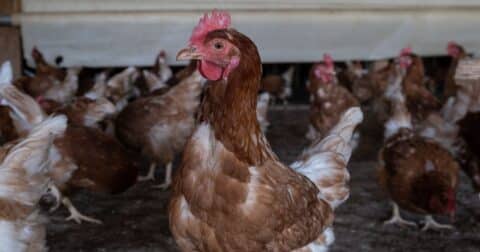Perspective
How Meat Became Cool Again in 2025
Diet•4 min read
Explainer
A brief explainer of the risks of avian flu for humans.


Words by Seth Millstein
Bird flu has been making a comeback, with multiple strains detected in multiple people across multiple continents over the last few months. As of this writing, three people in the U.S. have contracted the H5N1 strain, one person in Mexico has died from the H5N2 strain, and H5N1 has been detected in 118 U.S. dairy herds across 12 states. Thankfully, the disease is not easily transmissible between humans — but some epidemiologists fear that eventually, it will be.
Here’s what you need to know about bird flu and human health.
Bird flu, also known as avian influenza, is shorthand for influenza type A viruses and the illness they cause. Although avian influenza is common in birds, non-avian species can contract it as well.
There are many, many different strains of bird flu. However, most strains are what’s called low pathogenic, meaning they’re either asymptomatic or only cause mild symptoms in birds. For instance, low pathogenic strains of avian influenza, or LPAI, might cause a chicken to have ruffled feathers, or produce fewer eggs than normal. But high pathogenic strains of avian influenza, or HPAI, cause severe and often deadly symptoms in birds.
It’s important to note, though, that this distinction between LPAI and HPAI strains only applies when avian species contract it. A cow who gets an LPAI strain of bird flu might experience severe symptoms, for instance, while a horse who gets an HPAI strain might be asymptomatic. In humans, both LPAI and HPAI strains of bird flu can cause both mild and severe symptoms.
We sure can.
Bird flu strains are categorized on two different spectrums based on two different proteins on their surface. The protein hemagglutinin (HA) has 18 different subtypes, labeled H1-H18, while the protein neuraminidase has 11 subtypes, labeled N1-11. The two proteins combine with one another to create unique strains of bird flu, which is why strains have names like H1N1, H5N2, and so on.
Most of these strains don’t affect humans, but a handful of them do. Several strains have been particularly concerning to epidemiologists:
The current strain of bird flu that’s been detected in humans is H5N1.
In very rare cases, it’s possible for bird flu to pass from human to human. Most of the time, though, humans get bird flu by coming into contact with infected animals or their byproducts. This could mean touching the carcass, saliva or feces of an infected bird; however, bird flu is also transmissible by air, so merely breathing while in the vicinity of an animal with the virus can also be enough to contract it.
There are no documented cases of humans contracting bird flu by drinking raw milk, but some recent cases suggest that it may be a possibility. The current strain has been detected in cow’s milk, and in March, several cats died after drinking raw milk from a cow who’d been infected with the virus.
At the risk of stating the obvious, the symptoms of bird flu in humans are generally what one would describe as “flu-like,” including:
Birds who’ve contracted avian flu, on the other hand, might display slightly different symptoms, including:
Yes. In the three decades since bird flu was first detected, 860 humans have contracted it, and 463 of them died. This means the virus has a staggering 52 percent mortality rate, though there have been no deaths in the U.S. attributed to the most recent spread of the disease here.
Because the disease is primarily transmitted to humans through animals and their byproducts, people who spend time around animals are at the highest risk of contracting bird flu. Wild and farmed animals pose the greatest risk, but even dogs can get bird flu if, for instance, they come across the infected carcass of an animal who had it. Domestic pet owners whose animals don’t go outside are not at risk.
Occupationally-speaking, the people most susceptible to getting bird flu are those who work in the poultry industry, as they spend a significant amount of time around birds, their byproducts and their carcasses. But livestock workers of all sorts are at a high risk; the first person to test positive for this most recent strain works in the dairy industry, and is believed to have caught it from a cow.
Other people who face elevated risks of bird flu include hunters, butchers, certain conservationists, and anybody else whose line of work involves touching potentially infected animals or their carcasses.
The H5N1 strain has been slowly spreading across the globe since 2020, but it wasn’t until March that it was detected in the unpasteurized milk of U.S. dairy cows. This was significant for two reasons: it was the first known instance of that strain infecting cows, and it was discovered in multiple states. By April, it had spread to 13 herds across six different states.
Also around that time, humans began contracting H5N1. The first two people only experienced mild symptoms — pinkeye, to be specific — and quickly recovered, but the third patient experienced coughing and watery eyes as well.
That may sound like a minor distinction, but because a virus is much more likely to be spread through coughing than an eye infection, that third case has virologists on edge. All three were farmworkers who’d had contact with dairy cows.
By May, H5N1 had been detected in the muscle tissue of a dairy cow — though the meat didn’t enter the supply chain and had already been marked as tainted, as the cow was sick beforehand — and by June, cows infected with the virus had died in five states.
Meanwhile, a man in Mexico died after contracting H5N2, a different strain of bird flu that had never before been detected in humans. It’s unclear how he contracted it.
To be sure, there’s no reason to believe that a widespread outbreak among humans is imminent, or even possible (yet). But the fact that there have been so many bird flu “firsts” in such a short time has many experts concerned, as it raises the possibility that a strain could mutate and become more easily transmissible to humans.
While much of the coverage of H5N1 has focused on cows, the current outbreak has wrought havoc on chickens, too: As of June 20, more than 97 million poultry have been affected by H5N1, according to the CDC.
Absolutely not. If anything, coming into contact with raw milk increases your exposure to bird flu, not to mention your risk of contracting other potentially serious illnesses.
In April, the Food and Drug Administration announced that 1 in 5 milk samples from grocery stores were found to contain traces of H5N1. That’s not quite as alarming as it sounds; these milk samples were pasteurized, and preliminary studies show that pasteurization neutralizes, or “inactivates,” influenza type A viruses.
What’s especially worrisome is sales of raw milk have been increasing since the latest bird flu outbreak, spurred in part by viral misinformation spread by health influencers touting raw milk.
Though it’s difficult to say for certain, the general consensus in the scientific community is that the extant strains of bird flu are, in their current forms, unlikely to reach pandemic levels. The reason for this is that they almost never pass from one human to another, and are instead contracted from animals.
But viruses mutate and change over time, and the long-gestating fear among epidemiologists is that a strain of bird flu will mutate, or undergo a genetic reassortment, in such a way that allows it to be easily transmitted from human to human. If this were to happen, it could very plausibly become a global pandemic for humans.
In humans, bird flu is detected via a simple throat or nasal swab, but infectious disease experts warn that much like the early days of the Covid pandemic, we aren’t testing most of the population or measuring disease spread in wastewater. In other words, we don’t know for sure whether the disease is circulating. Physicians don’t routinely test for bird flu, so you’ll have to specifically request a test if you’re concerned that you might have it.
No. The current annual flu shot that we’re all encouraged to get protects against the common flu, including swine flu, but not avian influenza.
Development is underway for a new bird flu vaccine, and the CDC says that despite all of these recent developments, the public health risk of bird flu is still low. But there’s no assurance that this will always be the case; as a highly fatal virus with multiple, mutating strains, bird flu is a constant looming threat for humans and animals alike.